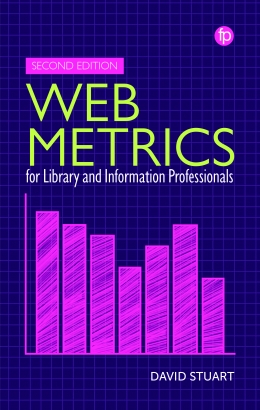
Primary tabs
You don't need to be an ALA Member to purchase from the ALA Store, but you'll be asked to create an online account/profile during checkout to proceed. This Web Account is for both Members and non-Members. Note that your ALA Member discount will be applied at the final step of the checkout process.
If you are Tax-Exempt, please verify that your account is currently set up as exempt before placing your order, as our new fulfillment center will need current documentation. Learn how to verify here.
- Description
- Table of Contents
- About the author
- Reviews
After reading this book the information professional will not only be better placed to adopt web metrics in their workplace, but also be critical of the misuse of web metrics.
Library and information professionals increasingly need to create, manage, and monitor a wide range of online content, from a library's social media account and web sites to the new and traditional research outputs that funders expect to be made available openly online. It is important that they understand the new opportunities that web metrics provide for measuring the impact of an individual or an organization's content. This book provides an up-to-date introduction to a wide range of web metrics, with practical examples of how they can be best put to use.
The book begins with a wider discussion on the role of metrics, and how web metrics overlap with associated concepts with a longer library and information science history such as scientometrics and bibliometrics. It explores the latest tools that are available, many of which have changed since the publication of the first edition, as well as how we can expect the field to change in the future with machine intelligence and artificial intelligence becoming more widely available.
This new edition has been extended and updated throughout to reflect the rapidly changing nature of the field. As well as updates to the user-friendly tools and resources, there is a greater emphasis on the programming libraries that are available, as library and information professionals are increasingly willing to start engaging with data that is available programmatically.
1 Introduction
Metrics
Indicators
Web metrics and Ranganathan's laws of library science
Web metrics for the library and information professional
Responsible metrics
The aim of this book
The structure of the rest of this book
2 Bibliometrics, Altmetrics, Web metrics, and Webometrics
Introduction
Web metrics
Information science metrics
Web analytics
Relational and evaluative metrics
Validating the results
Conclusion
3 Data Collection Tools
Introduction
The anatomy of a URL, web links and the structure of the web
Search engines 1.0
Web crawlers
Search engines
Post Search Engine 2.0: fragmentation
Conclusion
4 Evaluating Web Impact
Introduction
Websites
Blogs
Wikis
Internal v. External Metrics
Internal metrics
External metrics
A systematic approach to content analysis
Conclusion
5 Evaluating Social Media Impact
Introduction
Aspects of social network sites
Typology of social network sites
The most popular social media services
Sentiment analysis
Conclusion
**6 Relational Web Metrics and Social Network **
Analysis
Introduction
Social network analysis methods
Node centrality
Cluster identification
Statistical properties of the graph
Topic modelling
Sources for relational network analysis
Two R Examples
Conclusion
7 Web Bibliometrics
Introduction
More bibliographic items
New bibliographic sources
Full text analysis
Greater Context
Conclusion
8 Web Metrics for Data and Code
Introduction
The web of data
From data documents……to a semantic web?
The Importance of Code
GitHub Statistics
A Brief Exploration of Code-metrics with R Conclusion
9 The Future of Web Metrics and the Library and Information Professional
Introduction
How far we have come
The future of web metrics
The future of the library and information professional and web metrics
David Stuart
David Stuart is an independent information professional, Bibliometrics Officer at the University of St. Andrews and an Honorary Research Fellow at the University of Wolverhampton. He has published widely in peer-reviewed academic journals and professional journals on information science, metrics, and semantic web technologies and is author of a number of books, including Practical Ontologies for Information Professionals (2016), Facilitating Access to the Web of Data (2011) and Practical Data Science for Information Professionals (2020).
Have you read this book? Leave a review!
Praise for the first edition
"Will enable librarians to evaluate social media impact, web impact, relationships between entities on the web; and explore traditional publications in a new cyberspace environment. Of special note is Stuart's commentary on the future of web metrics and the library professional. A seminal work of impressive scholarship, Web Metrics for Library and Information Professionals is very highly recommended for practicing librarians in community, academic, corporate, and governmental library systems, as well as informational professionals charged with the responsibility for gathering, analyzing, interpreting, and reporting web metrics."
— Midwest Book Review
"Does Web Metrics for Library and Information Professionals provide a strong foundation for LIS professionals to explore the nature and potential of web metrics as a tool for building better web-based information services? The answer is unequivocally yes, and the book is recommended."
— Archives and Manuscripts
"A very interesting book that covers a range of technical areas. For anyone interested in bibliometrics who wants to better understand how the web presents both challenges and opportunities to the information science community then this is a great introduction. The author is clearly knowledgeable about metrics and makes some useful connections between the applied and research worlds. Any information professional or student wanting a considered overview of some of the key metrics for providing information services in a digital world would be advised to read it."
— Elucidate


